A month ago when Alek Manoah surrendered 11 runs to the Yankees’ rookie-level team in his return back to the minors, it was the latest nightmare in the long and strange 2023 season for last year’s AL Cy Young finalist.
The lowlights included his Opening Day start that featured five earned runs on nine hits, a start against the Rays in mid-May that saw him walk seven batters, and two other starts where he surrendered more than five earned runs. He was sent down to the minors in early June with a record of 1-7 and an ERA over 6.00.
Toronto called Manoah back up for a start before the All-Star break, and most fans didn’t expect what came next – Manoah got the win over the Tigers and pitched six innings.
It was a return to the version of Manoah who was the budding ace of 2021 and 2022, when he went a combined 25-9 with a 2.60 ERA over his first two seasons in the big leagues. So what’s behind his struggles this year and which Manoah can we expect the rest of the season?
Let’s start with Manoah’s background and the factors that led to his success in his first two seasons.
Almost Heaven, West Virginia
Manoah is a Florida native who graduated from South Dade High School in 2016. After going undrafted out of high school, he headed to play baseball at West Virginia University where he was named to the Big 12 All-Freshman Team after finishing his debut college season with a 1-1 record and a 3.07 ERA.
During his sophomore season, he took a step back as he struggled to a 3-5 record and an ERA that rose to 4.00. He then bounced back during his junior season and put himself on the radar of MLB scouts as he went 9-4 with a 2.08 ERA and racked up 144 strikeouts in 108.3 IP. His success caught the eye of the Blue Jays who drafted Manoah with the 11th overall pick in the 2019 MLB draft.
The first item that jumps out of Manoah’s prospect profile was his pure physical size (6’6″ and 260 lbs). Even back in college and his early minor league career, his build was more apropos of an NFL tight end than an MLB pitcher. His pitch mix included a fastball which he threw in the 94-97 MPH range, a plus slider, and a changeup.
There was some hesitation over the fact that he had an abbreviated career in the minors. However, going into the 2020 season, Manoah had climbed to the number four spot in Toronto’s system. His scouting report graded out as follows:
- Fastball: 65
- Slider: 55
- Changeup: 50
- Control: 50
- Overall: 50
Brief Minors Stint
Many players toil for years in the minors before they get their first taste of the major leagues, but when Manoah was called up by the Blue Jays on May 27, 2021, he had made only nine total starts in the minor leagues.
During his first season in the minors in 2019, Manoah started six games (17 IP) for the Vancouver Canadians of the Northwest League and had a 2.65 ERA with 27 strikeouts. He didn’t throw another official pitch until the 2021 season, due to the COVID-19 pandemic canceling the 2020 season.
Manoah started three games in Triple-A, going 3-0 with a 0.50 ERA before ascending to the big leagues, where he found immediate success.
During his first Major League start on May 27, 2021, he got the win after throwing a masterful quality start against the Yankees during which he allowed only two hits over six shutout innings and struck out seven.
He finished the 2021 season with a 9-2 record, 3.22 ERA, 1.05 WHIP, and 127 strikeouts, good for a rate of 10.2 SO/9.
No Sophomore Slump Here
Entering the 2022 season, the baseball community was expecting big things from Manoah, but you could argue he even exceeded those expectations. He went 16-7 and got stronger as the season progressed.
In September as the Blue Jays made a push for the Wild Card, he started six games. He held Toronto’s opponents to a .162 average and went a perfect 4-0 with a minuscule 0.88 ERA. Manoah also earned quality starts in all six appearances and even went more than seven innings in three of the outings.
In the end, his 16 wins were third in the American League, and he compiled a 2.24 EREA and a 0.99 WHIP. Manoah was also named a first-time All-Star and ended the season as an American League Cy Young Award Finalist. It seemed that Toronto had their number one-starter for the foreseeable future.
The future looked good, because this is what an ace pitcher looks like:
Pitch Arsenal
A deeper look at his pitch arsenal shows how he was able to find success during his first two seasons.
Last season his primary pitch was his four-seam fastball which he threw 36% of the time. Manoah averaged 93.9 MPH on the pitch and peppered the strike zone from the middle of the zone on up. This equaled hitters managing only a .212 average against it. The four-seamer had a run value of 19, which put the pitch in the top-15 of all major league pitches from 2022.
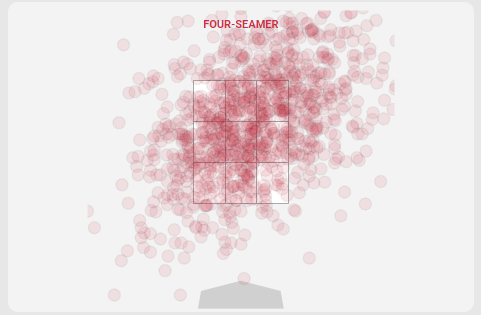
After the four-seamer, Manoah used his slider and sinker almost an equal amount of time (27% for the slider and 26% for the sinker) but it was the slider that was the most successful pitch during the 2021 and 2022 seasons.
He doesn’t throw the slider with a lot of heat – in 2021, it averaged 81.1 MPH, and in 2022, 81.5 MPH, which put him in the 11th percentile of all of baseball. However, he was able to find success against hitters based on the movement he put on the pitch.
In Manoah’s rookie season in 2021, his slider averaged 15.5 inches of horizontal movement. That was 7.9 inches more break than similar sliders thrown at the same velocity, which put him 8th in all of baseball. He was 14th in 2022 with 14.5 inches of movement which equaled 6.2 inches more break than average.
You can see that the pitch covered a wide swath of the batters’ box but tended to most frequently paint the bottom third of the strike zone and lower.

All of this led to a pitch that baffled hitters as they hit .168 against the pitch in Manoah’s first two seasons. The slider was highlighted in this Pitcher List video breakdown from 2021 which shows Manoah getting Alex Verdugo swinging on a 3-2 slider. Notice how the pitch dips low at the very last second.
The last pitch in Manoah’s repertoire is the changeup, a pitch he hasn’t used extensively. In 2022, he averaged 86.5 MPH on the pitch and threw it only 11% of the time. Early in the 2022 season, Manoah told MLB.com about his evolution with the changeup.
“I’m learning when to mix it in, how to mix it in,” Manoah said. “I feel like in college, I didn’t really need it. In the Minor Leagues, I didn’t really need it. Last year, I didn’t really need it a ton, but being able to mix that in and keep hitters off balance will be huge.”
He worked the change-up in with success in an April start against the Yankees, specifically catching Anthony Rizzo with the pitch during a strikeout. Manoah mentioned how his confidence with the pitch was growing.
“It’s come a long way,” Manoah said. “I’ve been telling you guys, man, the confidence is there and the movement is there. I feel really good throwing it. I’m going to go ahead and keep mixing that in.”
In 2022, he favored throwing the pitch low and away to left-handed batters and low and inside to right-handed batters. It kept hitters off balance when mixed in with his fastball, as the placement was a stark contrast to his fastball hitting high in the zone. He kept the changeup in a more compact placement as compared to his slider.

2023 Struggles
This brings us to 2023 when many different factors have gone poorly for Manoah.
Much has been made of the pitch clock messing with his rhythm, and there may be some truth to that theory. Manoah was consistently one of the slowest working pitchers in 2022, so it would make sense that he was among those most affected by the implementation of the pitch timer. He was 29th in all of baseball in pitch tempo when the bases were empty (“slow” 8.2% of the time) and 45th with runners on base (“slow” 20.5% of the time).
In 2023, Manoah has had to speed up his tempo and is now classified as slow only 0.9% of the time with the bases empty and 2.4% of the time when runners are on base. He’s still among the top 40 slowest-working pitchers in both categories.
If he is feeling rushed, it is manifesting itself in less control and worse pitch location. He’s had major drops in the placement of his primary pitches and he’s throwing fewer strikes. His fastball Zone% is 44.9% – a drop of 9% from last season and his slider is at 34.6% – a drop of 5.6%. The slider control has particularly hurt him as that has historically been his punch-out pitch when he has hitters sitting on two strikes.
Here is an example from his June 5th start against the Blue Jays. He had Yainer Diaz in a 0-2 hole and threw a slider but instead of the typical dropoff we would have seen last season, Manoah hung it over the plate and Diaz knocked it for a base hit.
The inability to place the slider has led to much better results for hitters:
2022: .190 average, .245 wOBA, .247 BABIP, 5.8% HR/FB%
2023: .268 average, .375 wOBA, .341 BABIP, 15.4% HR/FB%
His walks are also way up with a BB% that has jumped to 14.7% from 6.5% in 2022. This has equaled averaging 6.3 BB/9 innings compared to 2.3 in 2022.
By issuing more free passes, Manoah is commonly having to pitch out of jams and this has limited his ability to get into a rhythm, shortening his starts. His starts have averaged 4.5 innings in 2023, almost down two full innings from his 6.3 innings per start in 2022.
Velocity is another area where Manoah has regressed this season. In 2022, his fastball averaged 93.9 MPH and it dropped a full tick in 2023 to 92.8 MPH. His slider (80.8 MPH down from 81.5 MPH), sinker (92.7 MPH down from 93.3 MPH) and changeup (86.2 MPH down from 86.5 MPH) have also all decreased in speed.
The combination of poor location and less velocity has led to hitters taking advantage of his four-seamer as well. In 2022, hitters had a .213 average against Manoah’s primary pitch – that has jumped to .310 this season. That’s a Hall of Fame average against what had been Manoah’s most commonly thrown pitch thus far in his career.
Can He Turn It Around?
With two months left in the season, the question is – can Manoah turn it around?
He has shown definite progress in July with hints that he may be able to right the ship. In his July 7th start against the Tigers, the first since being called back up from the minors, he had eight strikeouts over six innings and only allowed one run on five hits. He had his slider back working and hitting in the right spots.
In the first inning, he struck out Spencer Torkelson with a backdoor slider on a full count that hit just at the edge of the strike zone.
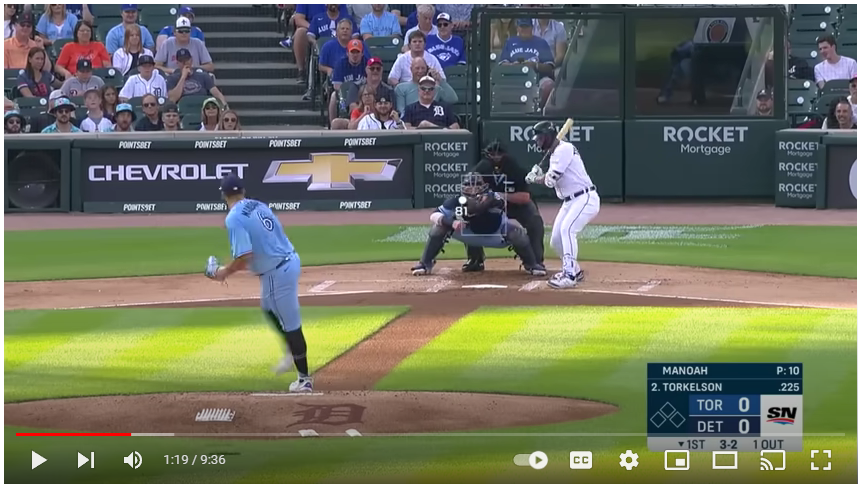
In the second inning, Manoah struck out Akil Baddoo with a slider that looked reminiscent of last season.
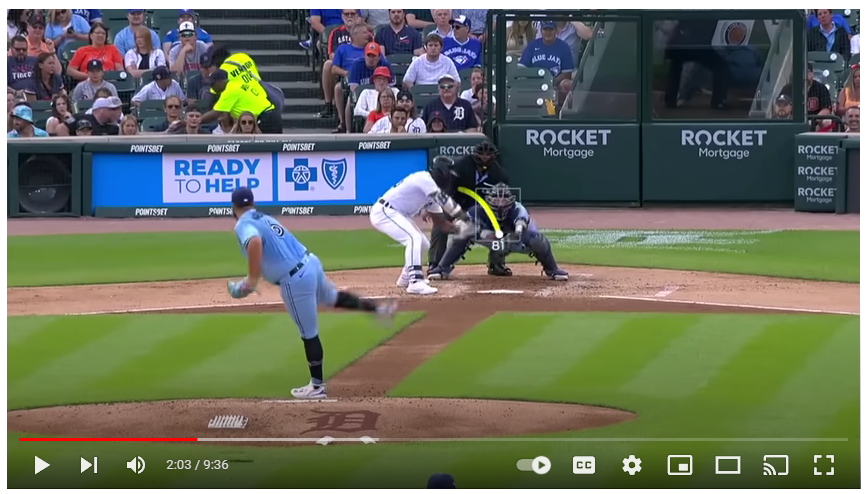
The 81 MPH pitch started high and then broke down low at the last second.
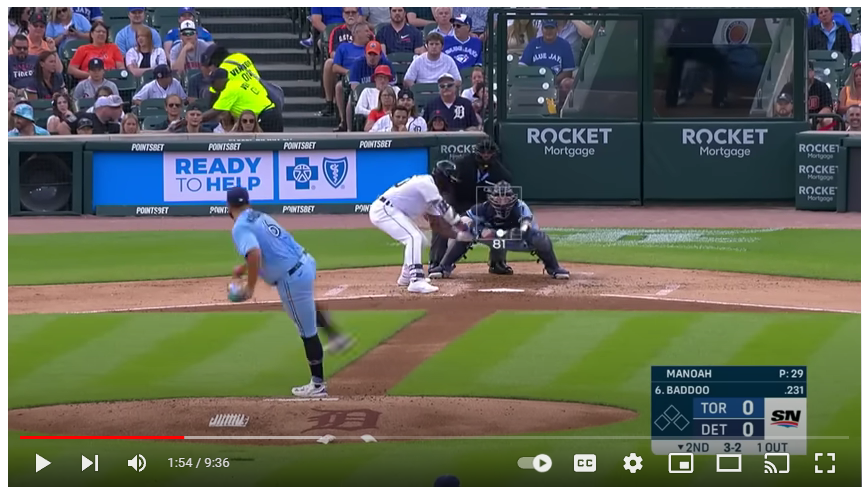
He was still going strong in the sixth inning and used a high fastball that touched 94 MPH for another strikeout.
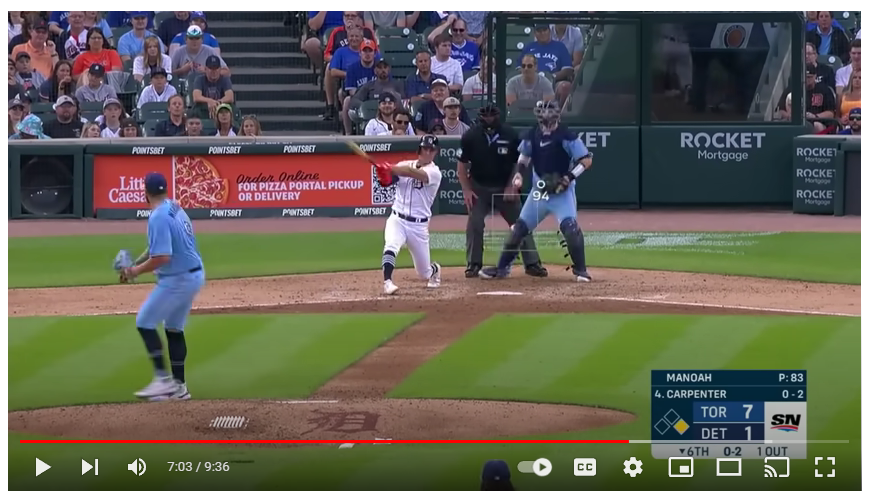
He had another poor outing in his next time out, with four earned runs and five walks in three innings, but then rebounded with an adequate start earlier this week against the Mariners.
The Blue Jays won 4-3 as Manoah went 5.1 innings and allowed three runs on three hits. He didn’t get the decision in the game but did enough good things for the Blue Jays to prevail and limited the damage.
Manoah told MLB.com it was a positive step. “I feel really good. You’ll never get to a point in this game where you feel like you’ve got it all figured out,” Manoah said. “If you do, it’s never going to end well. For me, it’s just about continuing to hone my craft and making adjustments from start to start. I just want to stay aggressive every time I’m out there.”
His strategy was to return to using his fastball as the primary pitch with the slider following. “Being able to establish the fastball was the main part,” Manoah said, “getting ahead with that and putting them in swing mode. Then, it was about being able to mix in the good sliders.” After that start, his record now sits at 2-8 with a 6.10 ERA and 1.80 WHIP on the season.
Projecting the next two months, I would not expect a dominant run like Manoah had last September. However, it’s not unreasonable to think he can find better consistency the rest of the way and pick up additional wins and lower his ratios in the process. If I had to predict a final record – I would say he finishes just under .500 and lowers his ERA into the 4.00s.
Let’s remember he will still be only 26 years old at the start of the 2024 season and young pitchers typically have a run of inconsistency before they figure things out. With a full offseason to make tweaks and further adjustments, Manoah will be able to put 2023 behind him and return as an ace next season.

